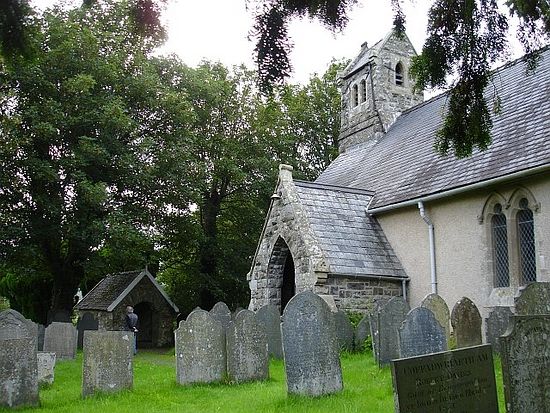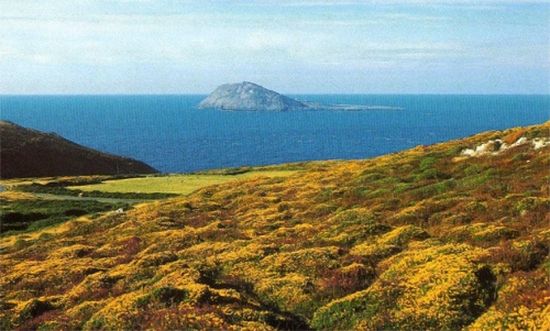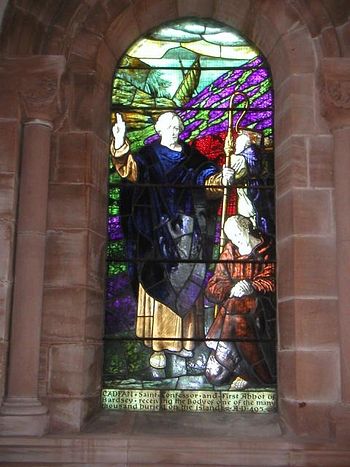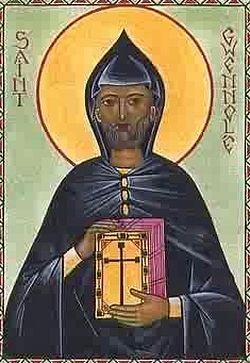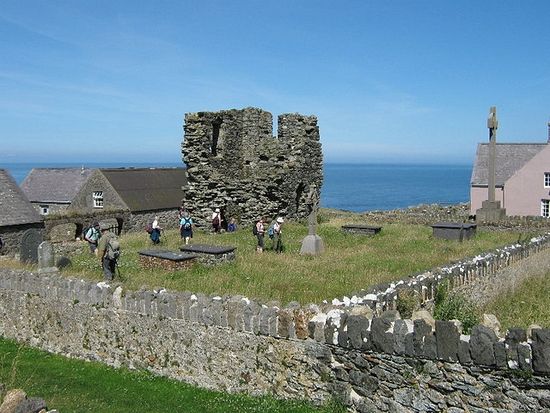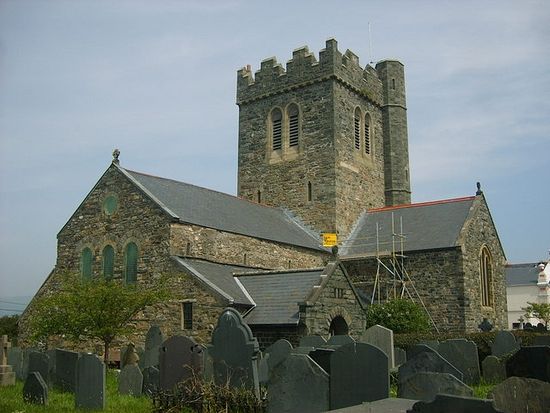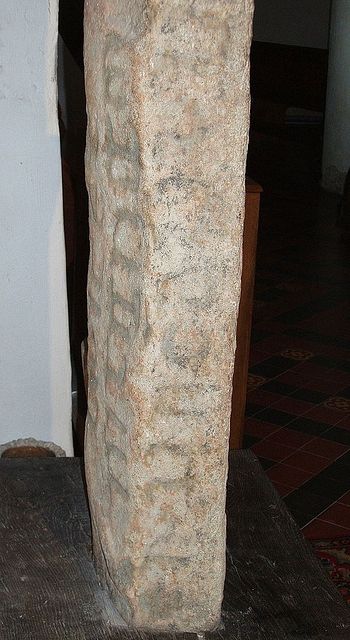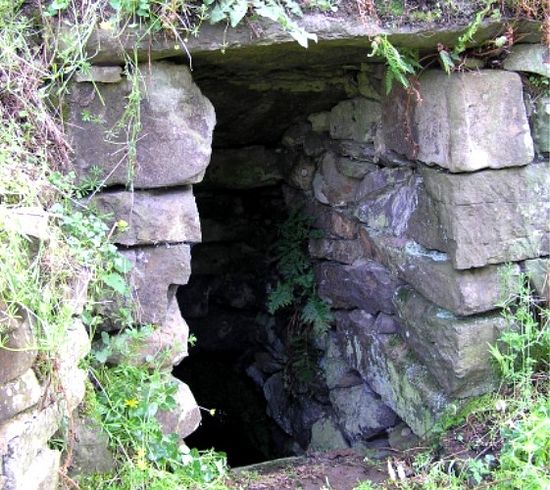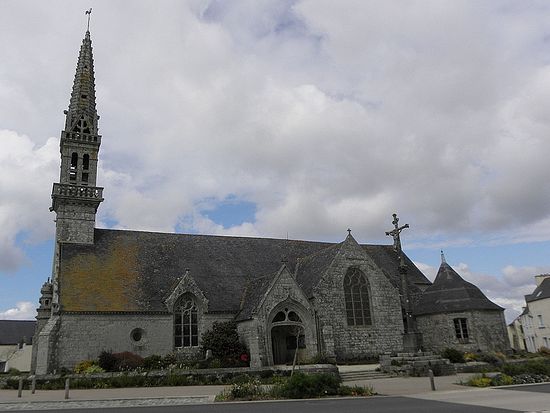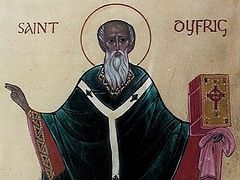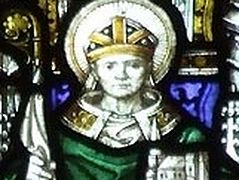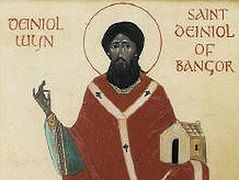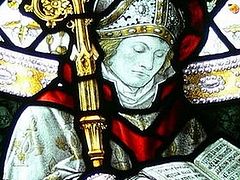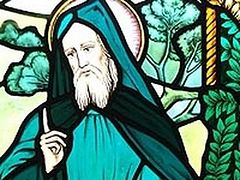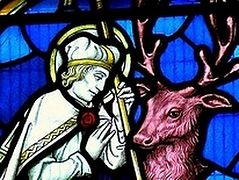Wales forms just a small part of the island of Great Britain and consists mainly of the actual peninsula of Wales with the isles of Anglesey, Bardsey and a group of tiny isles near it. But in spite of its very small territory this land produced a great many saints in the first centuries of Christianity, and these early saints are still a part of the national identity of Welsh people. Wales became a true seedbed of Orthodoxy, culture, education and strict ascetic life. It is not known for certain how many saints shone forth in the Welsh land, but their number can be compared with that of all saints who lived in England!
Christianity may have reached Wales as early as the first century, and by the fifth century the Welsh inhabitants who had never been invaded by barbarians from continental Europe had received the Orthodox monastic tradition of Egypt through their contacts with Gaul. Absorbing the Egyptian model of monasticism, the Welsh saints very quickly enlightened their own country, spreading the spirit of holiness to Dumnonia (the regions of Cornwall, Devon, and partly Dorset and Somerset), Brittany (then Armorica), southern Ireland, and even northern England and Scotland. Numerous monasteries, convents and monastic schools were opened. A multitude of anchorites and anchoresses chose to retreat to the wilderness—to bogs, forests, and small offshore isles, gradually forming great monastic centers. The most famous of the “insular” hubs of monastic life were on Anglesey and Bardsey.
Bardsey, or Ynys Enlli in Welsh (its English name means “the isle of bards” and the Welsh name means “the isle in the currents”), lies off the Lleyn Peninsula of the Welsh county Gwynedd. It is about 1.5 miles long and 0.6 mile wide. Its current population is under ten people. Bardsey is also called holy island, and “the island of 20,000 saints” because, according to an ancient tradition, thousands of monks and other ascetics who gained the gift of prayer were buried in its soil in olden times. Indeed it makes Bardsey one of the holiest sites in Britain.
After St. Cadfan had founded the first monastery here in 516, it became an important center of monastic life. Throughout the Middle Ages, numerous pilgrims flocked to Bardsey from Britain and beyond, and many strove to be buried there, believing that physical closeness to the host of saints who had dwelt there would somehow contribute to their salvation. It was also recorded that all who lived on Bardsey reached extremely old age and never died of disease. In 1212 a Catholic Augustinian Monastery of the Mother of God was founded on Bardsey which thrived until the closure of all the island’s monasteries in 1537 under Henry VIII. The shores of Bardsey have always attracted painters, musicians, poets, bards and simple worshippers due to its picturesque nature, wildlife and the ineradicable spirit of sanctity. (Among other things, Bardsey is a haven for every species of seabirds and plants, including several rare ones).
In the first centuries A.D., it is said that it became a refuge for British Christians who fled here from mainland Britain, escaping Roman persecution. From the early sixth century on, hundreds of monks lived there permanently, and bards used to call the island “a direct path to heaven” and “the gates of Paradise”. Due to such island monasteries as those on Bardsey and Anglesey, Wales was rightly called “the thebaid of the saints”. While most of Western Europe adopted Roman Catholicism in the eleventh century, the Orthodox Celtic monastery on Bardsey existed till the beginning of the thirteenth century! Today thousands of Christians of various traditions, including Orthodox, make pilgrimages to Bardsey—to venerate the earth that was sanctified by a host of saints. Only ruins of the ancient monastic buildings can be found there today. A thirteenth-century roofless bell-tower is otherwise practically intact and services are occasionally held in it. There is also a whole ancient Celtic cross on Bardsey, marking the site where “20,000 saints are buried.”
Apart from Cadfan, other noted saints were originally buried on Bardsey; among them we can mention Dyfrig (who lived here as a hermit shortly before his death), Deiniol of Bangor and Lleuddad (successor of St. Cadfan as Abbot of Bardsey). Perhaps the most amazing relic of Bardsey is its miraculously-surviving 1000-year-old apple-tree which was discovered in 1998. It is twisted because of old age but it is still fruit-bearing. Experts from the National Fruit Collection in Brogdale (Kent) have ascertained that it is a unique and long-forgotten variety—the “Bardsey apple”—which is exactly 1000 years old! The apple is now being successfully spread by grafting. Thus this very apple-tree was looked after by Orthodox monks in the monastic orchard 1,000 years ago, and it is a true miracle that it has stood until today. After the Reformation, some precious relics from Bardsey were rescued and removed to mainland Wales. The first post-Reformation service on Bardsey was held over 300 years after the dissolution. There has been a Methodist chapel on the island since the 1870s.
One of the greatest and most venerated “insular saints” of Wales is St. Cadfan (c. 490-c. 542; according to another version: c. 530-590). Other forms of his name are Catamanus and Caiman. According to tradition, the mother of St. Cadfan was the saintly woman named Gwen Teirbron (feast: October 18/31), who reputedly was a sister of St. Nonna, the mother of St. David of Mynyw. St. Gwen may have had other children who are listed among the saints; one of them is St. Cybi.1
Born either in Brittany or south-eastern Wales, St. Cadfan studied under St. Hywyn of Aberdaron and also probably under his relative, St. Winwaloe of Landevennec. It is possible that the Venerable Paternus (Padarn) of Llanbadarn Fawr was a distant relative of his. Young Cadfan was destined to become one of the first preachers of the Orthodox faith in Wales and one of the chief founders of monasticism in the west of this country. Already as a young man, Cadfan erected churches and established monastic communities in the Finestere and Cotes-d-Armor departements of Brittany and later moved to Wales, and, at the head of a group of ascetic missionaries (among whom was his saintly disciple Maelrhys of Bardsey and others), he proceeded to the west. Owing to the labors of these God-chosen men, many churches, chapels and monasteries appeared in the region.
But the name of great Cadfan was not forgotten, mainly due to the building of the famous church in Tywyn (the original name: Towyn) in Gwynedd in northwestern Wales, and the Monastery of St. Mary (dedicated to the Mother of God) on the island of Bardsey. Cadfan became the first abbot of Bardsey. This very large monastery gradually obtained the status of a great monastic center in Wales. It was here, in the abbey’s cemetery, that no fewer than 20,000 monks found their rest over the centuries. Bardsey Island was with time nicknamed the “Iona of Wales”. In the late Middle Ages it was considered that three pilgrimages to the holy island of Bardsey were equal to one pilgrimage to Rome!
For twenty-six years St. Cadfan ruled his monastery on Bardsey, at the same time he would often retreat to seclusion for solitary prayer and contemplation—a favorite practice of Celtic saints who imitated the lives of the Egyptian Fathers. It is known that during his life Cadfan undertook numerous missionary journeys literally to all the regions of Wales, founding houses of God and preaching the Good News of Christ—that is why a large number of places across the country still bear his name and quite a few Welsh churches are dedicated to him. Notably, during one of his evangelization trips, the saint established either a church or a monastery at Llangadfan (“church of Cadfan”) in what is now county Powys, but earlier the district was called Montgomeryshire.
Sadly, the place of St. Cadfan’s death is unknown: it may have been either Tywyn or Bardsey Island. Several centuries later, his holy relics were transferred to Llandaff Cathedral. For hundreds of years Bardsey Island, Llandaff Cathedral and Tywyn church were destinations for mass pilgrimages, where through Cadfan’s and other local saints’ prayers countless miracles occurred. Venerable Cadfan is commemorated as the principal saint and heavenly patron of Bardsey Island. Interestingly, for a long time this holy man was also venerated as the patron-saint of military men, because according to tradition, the saint had been a soldier before taking up monasticism. Many fishermen of western Wales regarded him as their holy protector as well, and this veneration continued until as late as the nineteenth century.
The church at Tywyn survives to this day. For many centuries the faithful flocked to this temple and the chapel with the holy well of St. Cadfan near it, believing that its water healed skin diseases, rheumatism, and scrofula. Regular pilgrimages to this holy site continued for a long time even after the Reformation, when the veneration of saints and holy places was officially prohibited. Bathrooms and changing rooms were built near the spring. Unfortunately, by the nineteenth century the influx of pilgrims dramatically diminished, the well became overgrown, and little survives of the buildings now. The church of Tywyn still preserves the unique large stone cross called “the Cadfan stone” of the eighth or ninth century, which once lay near to his grave and marked the site of his burial. An inscription on the stone can be distinguished, which reads approximately the following: “Beside under a similar slab in the ground the holy and blessed man named Cadfan lies, and may his body ever rest incorrupt.” This relic is perhaps the earliest known inscription in Old Welsh in existence.
Today Tywyn is a town on the shore of Cardigan Bay in the south of the county of Gwynedd. The local St. Cadfan’s Church dates from the Norman period. The original church, built by the saint, was destroyed by the Vikings in the tenth century and restored only two hundred years later. The church in the village of Llangadfan in the county of Powys is dedicated to St. Cadfan. The present church is medieval (roughly the fifteenth century), although the first church on the site was built by the saint himself between 510 and 515. It is speculated that this church may have been erected by Cadfan before his departure to Bardsey. Cadfan is the patron of this little village. The holy well of St. Cadfan which is still full and has clear water is situated just outside Llangadfan. A road was going to be built over this well in the nineteenth century, but thanks to the intervention of a local clergyman an arch was installed and the holy site saved from destruction.
Among the sites that bear the name of St. Cadfan let us mention the village of Rhosgadfan in Gwynedd, more known as the birthplace of the most prominent twentieth-century Welsh female author and novelist Kate Roberts (1891-1985), along with a number of places in the vicinity of Tywyn, through which, according to tradition, he travelled to Llangadfan: Pistyll Gadfan (“the waterfall of Cadfan”), Llwbyr Gadfan (“Cadfan’s path”), Eisteddfa Gadfa (“Cadfan’s seat”), Dol Gadfan (“Cadfan’s meadow”), and Buarth Gadfan (“Cadfan’s enclosure”).
One of the chapels of Llangathen Church of St. Cathen in the county of Carmarthenshire in South Wales is dedicated to our saint, and nearby is the spot called Llethr Codfan (“Cadfan’s slope”). Outside Wales St. Cadfan is also venerated in Brittany, France, where, for example, he is the patron of the parish church in Poullan-sur-Mer under the name “Cadoan” (Finistere); a statue of him can also be found at the chapel of St. Venec in Briec (Finistere). However, modern research supposes that it is another obscure saint with the same name who lived in France, not St. Cadfan of Bardsey. But our St. Cadfan is definitely commemorated and honored by the faithful of the Finistere and Cote-d’Armor departements to this day. Orthodox Christians celebrate his memory on November 1/14, and Catholics and Anglicans commemorate him on November 1 which is also All Saints’ Day in these denominations.
Holy Father Cadfan of Bardsey, pray to God for us!

